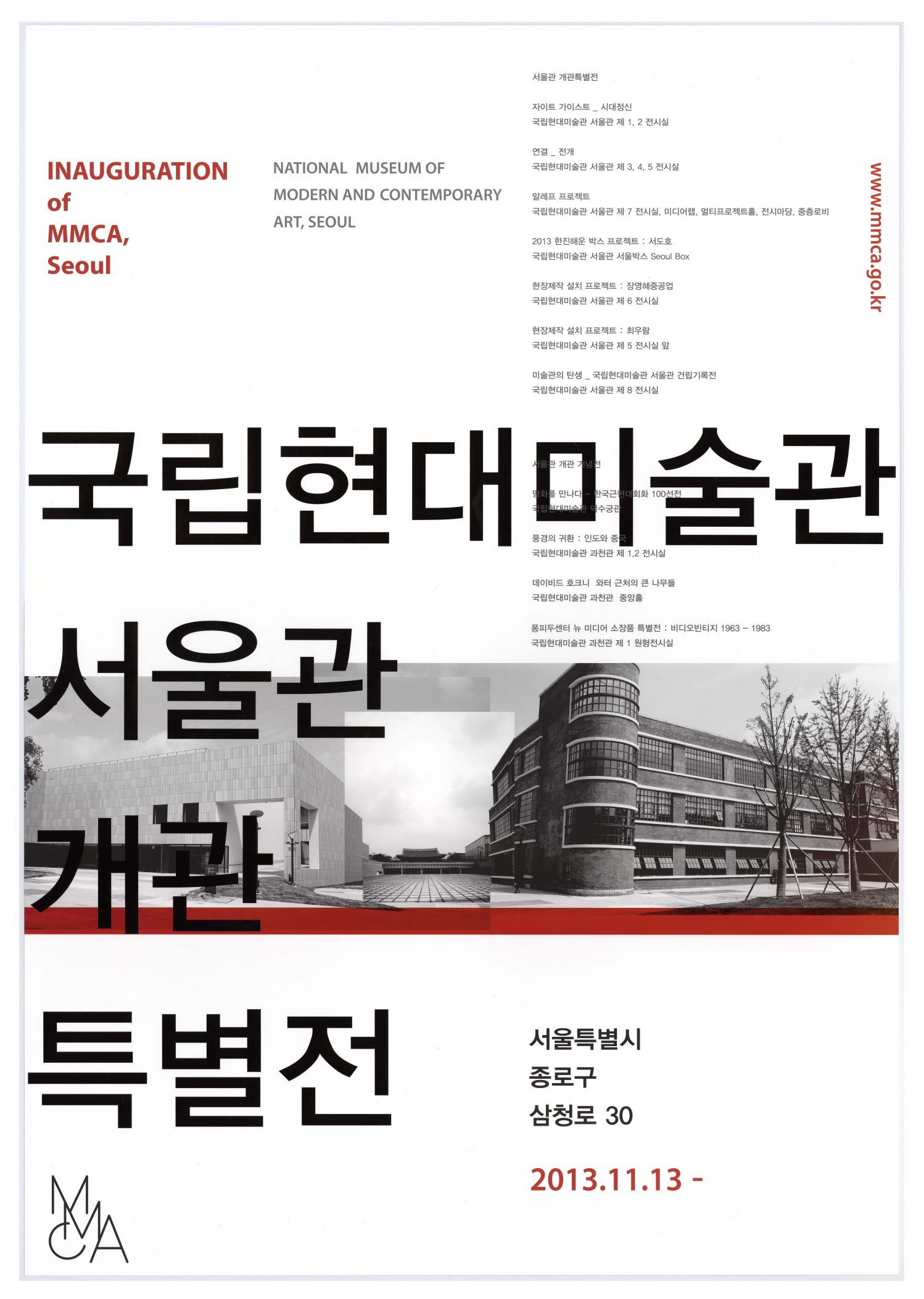
Inauguration of MMCA, Seoul, Poster, 2013, MMCA Art Research Center Collection
Zeitgeist Korea
* Source: MMCA
Related
-
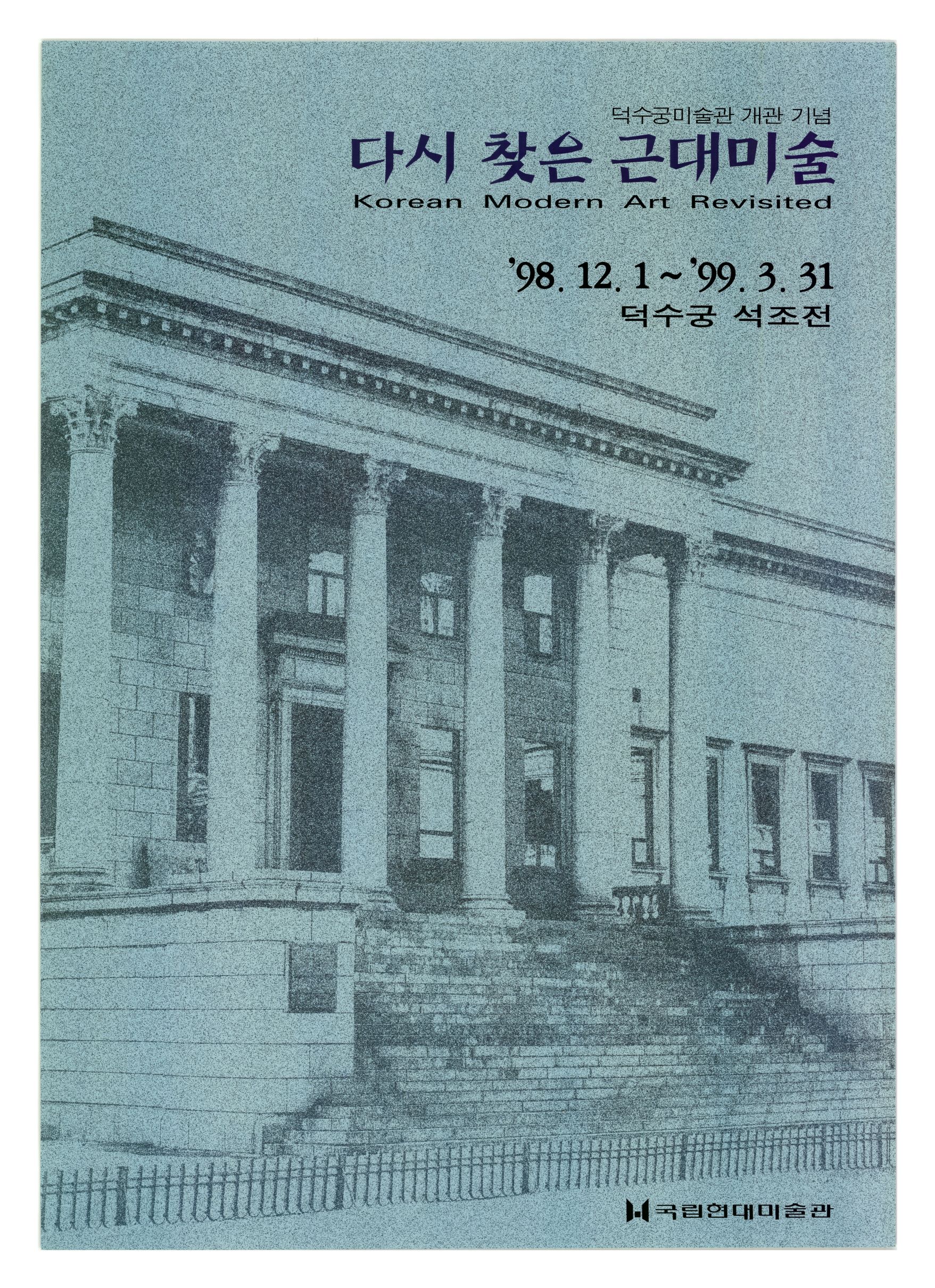
Korean Modern Art Revisited
Korean Modern Art Revisited was a special exhibition held by the National Museum of Contemporary Art (now MMCA) in Seokjojeon Hall at Deoksugung Palace from December 1 in 1998 through March 31 in the following year to coincide with the opening of the MMCA’s Deoksugung branch. As the MMCA was relocated to a new museum built in Gwacheon in 1986, the Western Building of the Deoksugung Palace, which had been used as the Bureau of Cultural Heritage Management, was reopened in 1998 as the Deoksugung Palace branch of the MMCA. The MMCA declared that its Deoksugung Palace branch would be operated as an art museum specializing in exhibitions and research on modern Korean art. The Deoksugung Palace branch held the inaugural exhibition Korean Modern Art Revisited with the intention of bridging the gap between Korean modern and contemporary art. There were 146 works on display, including forty-nine works by twenty-six ink-and-wash and polychrome painters, eighty-three works by forty-three oil painters, and fourteen works by six overseas Korean artists. In line with its intention to restore the lost history of modern Korean art, the exhibition unveiled for the first time the works by artists who defected to North Korea and had been excluded from Korean art history, including Lee Yeoseong, Pai Unsoung, Chung Chong-you, Gil Jinseop, and Lee Qoede. It also displayed works by artists active in Central Asia, Japan, and other foreign countries, such as Shin Sunnam (Nikolai sergeevich Shin), Park Seongyong (Nikolai Park), Cho Yanggyu, and Chun Huahuan. Moreover, it unearthed and exhibited works by artists who had not been spotlighted in South Korea, including Jin Hwan, Park Myungjoe, Kim Seyong, and Choi Keunbae. This exhibition was the first to highlight the MMCA’s role in reconstructing modern art history by discovering and exhibiting lost or forgotten modern artworks. Until the opening of its Seoul branch in Sogyeok-dong in 2013, the MMCA maintained a dual system. The main building in Gwacheon focuses on contemporary art while the Deoksugung Palace branch emphasizes modern art.
-
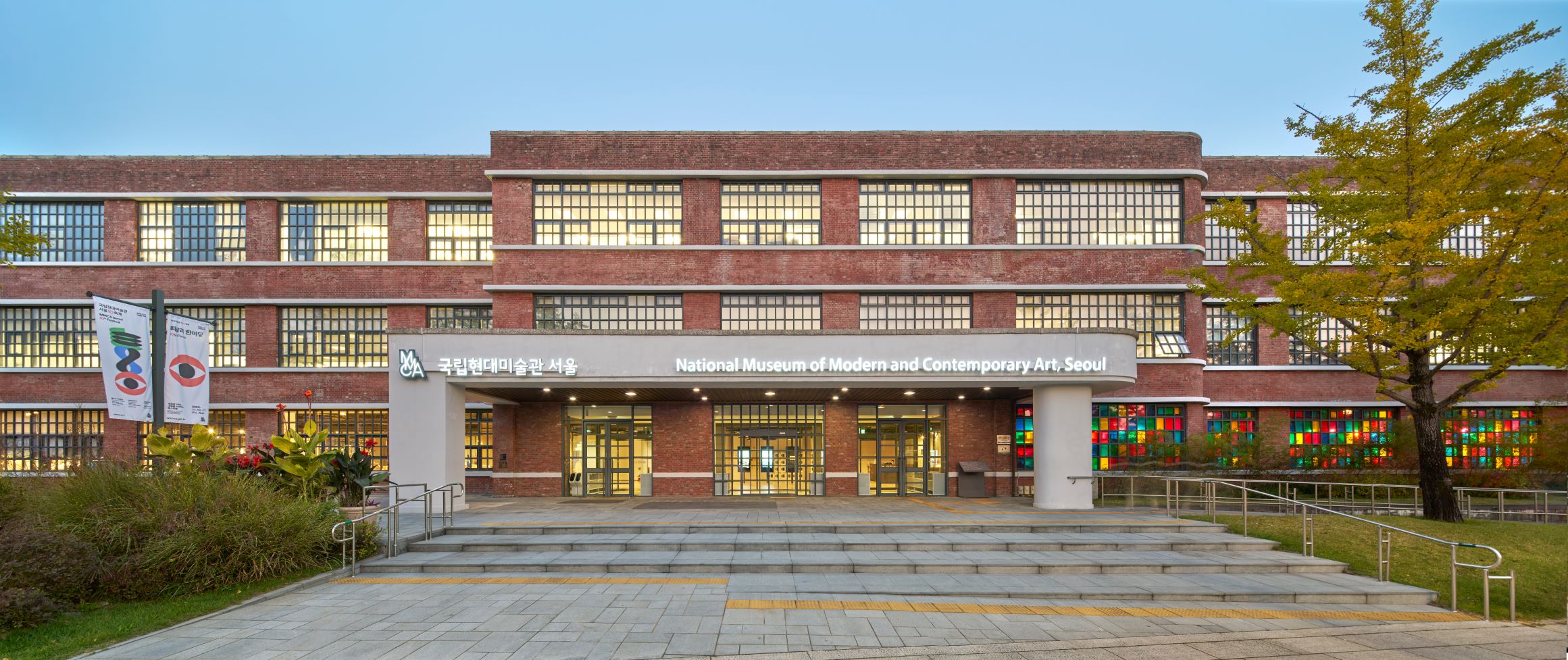
National Museum of Modern and Contemporary Art, Korea (MMCA)
A national museum established in 1969 that researches, collects, and exhibits modern and contemporary art. As of 2018, there are branches in Gwacheon, Deoksugung, Seoul, and Cheongju. When first established, the National Museum of Modern Art (now MMCA) was located within Gyeongbokgung palace. In 1973, the museum moved to the East Wing of the Deoksugung Seokjojeon building. Then, in 1986, the museum moved to its current location in Gwacheon, to occupy a new building equipped with an outdoor sculpture exhibition space, and has since opened a new chapter in Korean art. The perceived need for a space to focus specifically on Korean contemporary art led to the establishment of further site, the National Museum of Contemporary Art, Deoksugung in 1998. In November 2013, a further demand for contemporary art exhibitions led to the establishment of another Seoul branch being created in the Defense Security Command building in Sogyeok-dong, Jongno-gu, which has since its inception engaged in multifaceted exhibitions of both domestic and overseas contemporary art. Also, as a further component of the MMCA complex, a disused tobacco factory in Cheongju was remodeled to provide a home to the National Art Storage Center.
Find More
-
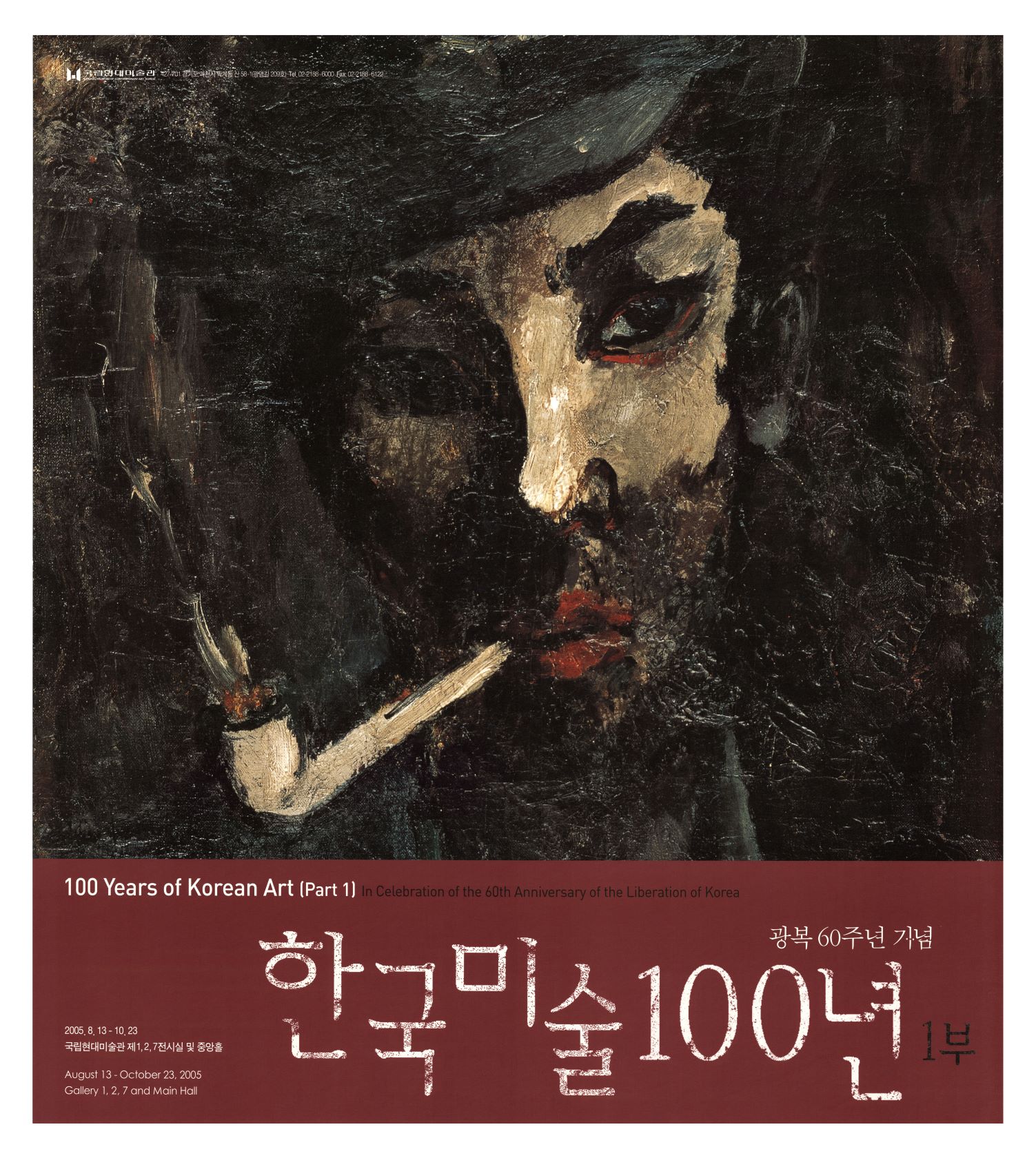
100 years of Korean art
100 Years of Korean Art was a special exhibition held at the National Museum of Contemporary Art, Korea (now MMCA) to commemorate the sixtieth anniversary of Korea's independence. It offered an overview of Korean art from 1905 to 2005 in two parts. Art historian Kim Hyunsook orchestrated the entire project. Part 1, which covered art from 1905 to 1959, was held from August 13 to October 23 in 2005, and Part 2, which oversaw art from 1960 to 2005, was held from June 2 to September 10, 2006. Part I of the exhibition was segmented into six periods as follows: “Prehistory—Towards Modernity: 1876-1905,” “Between Enlightenment and the Anti-Japanese Movement: 1905–1919,” which oversaw visual art during the anti-Japanese and patriotic movements as well as contemporaneous Korean art as seen by foreigners; “The Bright and Dark Sides of the New Culture: 1919–1937” focusing on the art that evolved by accepting new cultural trends and was directed toward autonomous modernity; “From Modernism to Imperial Citizens: 1937–1945” covering avant-garde art to pro-Japanese art; “Liberation and Division: 1945–1953” focusing on art created after liberation from Japan under the US military government, and during the Korean War; and “The Shadow of the Cold War: 1953–1960.” Part 2 of the exhibition was divided into four themes and periods: “1957–1966: Invitational Exhibition of Contemporary Artists” showing the proliferation of the new post-war art form, Art Informel, under the subtitle “Tradition, Humanity, Art, Reality”; “1967–1979: Young Artists' Union Exhibition," focusing on experimental art; “1980–1987: 5.18 Gwangju Democratization Movement,” displaying socially engaged art and folk art; and “1988–Present: Seoul Olympics,” overseeing the post-modernist and globalization trends in the late 1980s. As 2006 marked the 20th anniversary of the relocation of the National Museum of Contemporary Art, Korea from Deoksugung Palace to Gwacheon, the academic events that were part of the first and second exhibitions of 100 Years of Korean Art were posted online and named the "20th Anniversary of the Relocation to Gwacheon Online Exhibition." 100 Years of Korean Art was a new kind of exhibition that attempted to include not only fine art, but also visual culture in general, including painting, sculpture, calligraphy, crafts, design, advertising, photography, film, and architecture, as well as archives, in Gallery 1, 2, and 7 and the central hall of the National Museum of Contemporary Art, Korea Gwacheon. It was also an attempt to show 100 years of Korean art as an integrated product formed in political, social, and cultural contexts. The exhibition catalogue for Part I was published in 2006 as a 707-page book by Hansgilsa Publishing Co. with the participation of Kim Yoon-Soo and fifty-seven other contributors. The exhibition catalogue for Part 2 was published in 2006 as a 45-page book by the National Museum of Contemporary Art, Korea.
-
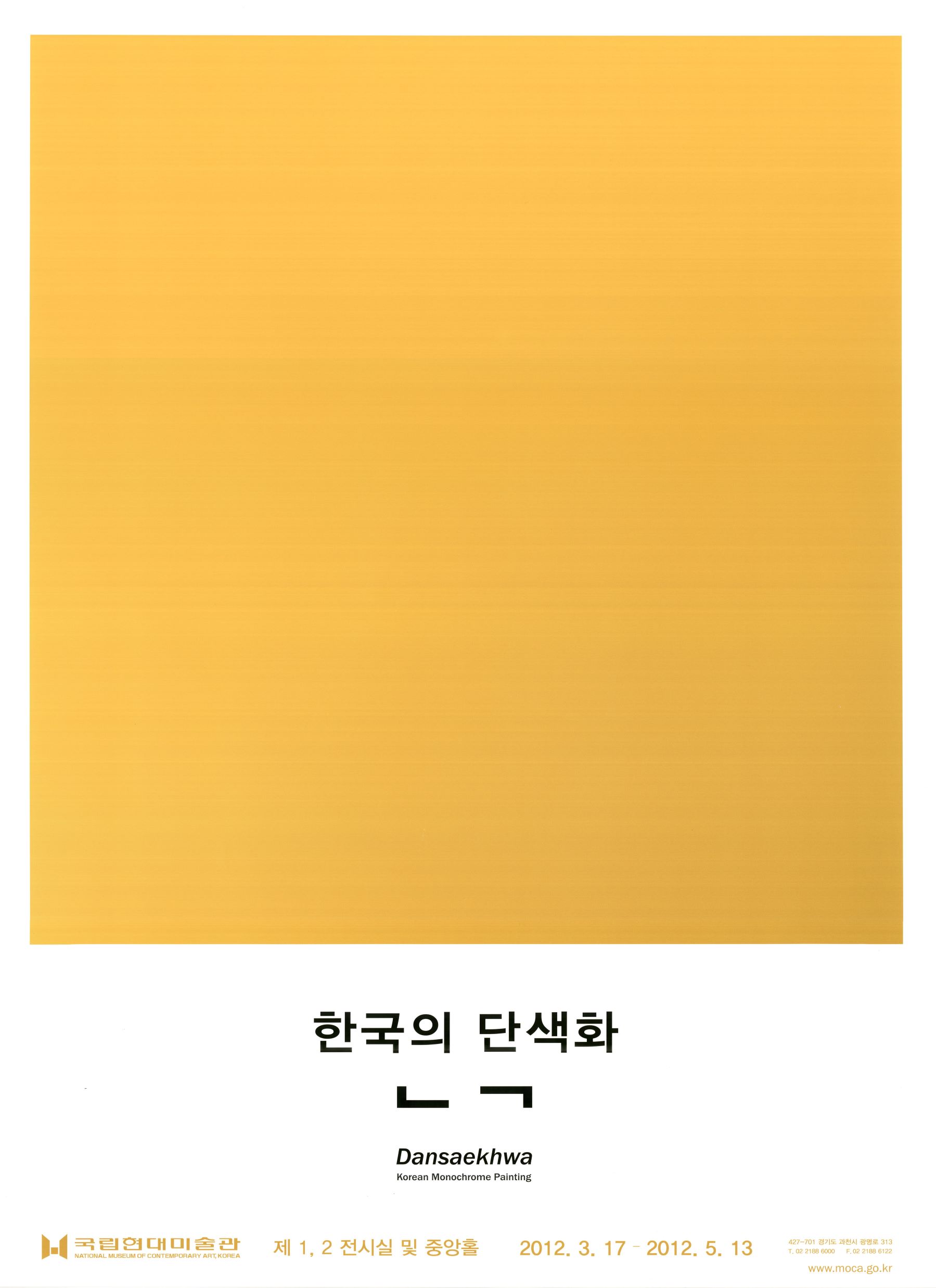
Dansaekhwa: Korean Monochrome Painting
Dansaekhwa: Korean Monochrome Painting was an exhibition held at the National Museum of Contemporary Art (now MMCA) from March 17 to May 13 in 2012. The curator Yoon Jinsup brought together monochromatic paintings with a variety of senses and perspectives from the 1960s through the 2000s and beyond. The participating artists were Quac Insik, Kwon Youngwoo, Kim Guiline, Kim Jangsup, Kim Whanki, Park Seo-Bo, Suh Seungwon, Youn Myeungro, Yun Hyongkeun, Lee Dongyoub, Lee Ufan, Chung Sanghwa, Chung Changsup, Choi Myoungyoung, Choi Byungso, Ha Chonghyun, Hur Hwang, Koh Sankeum, Kim Tschoonsu, Kim Taeho, Kim Taeksang, Nam Tshunmo, Noh Sangkyoon, Moon Beom, Park Kiwon, An Jeongsuk, Lee Kangso, Lee Bae, Lee Inhyeon, Jang Seungtaik, and Cheon Kwangyeop. Perceiving tranquility, white clothes, and the sentiment of “han” (resentment or sorrow) as the “archetype” that forms the core of the collective unconscious of Koreans, Yun Jinseop interpreted the preference for Dansaekhwa (monochrome painting) as the identity of Koreans and curated the exhibition entitled Dansaekhwa: Korean Monochrome Painting. He viewed that the trend of Dansaekhwa was seen already in the 1960s works of Kim Whanki, Quac Insik, and Lee Ufan, but the official beginning of Korean Dansaekhwa originated from Lee Ufan and Yamamoto Takashi from Tokyo Gallery paying attention to Situation by Lee Dongyoub and Variable Consciousness by Hur Hwang, both of which were submitted to the first Independants in 1972. He also divided Dansaekhwa into early monochrome painting which emphasized the repetition of performances and actions in the 1970s, and late monochrome painting, which used various materials in and after the 1980s. This exhibition marked a turning point in the use of the term “Dansaekhwa.” In the 1970s, such paintings were called “monochrome” and later “monotone painting.” However, they came to be written using the proper noun Dansaekhwa. The use of the term Dansaekhwa spread quickly and became common, coinciding with the situation in which monochrome painting attracted international attention.






